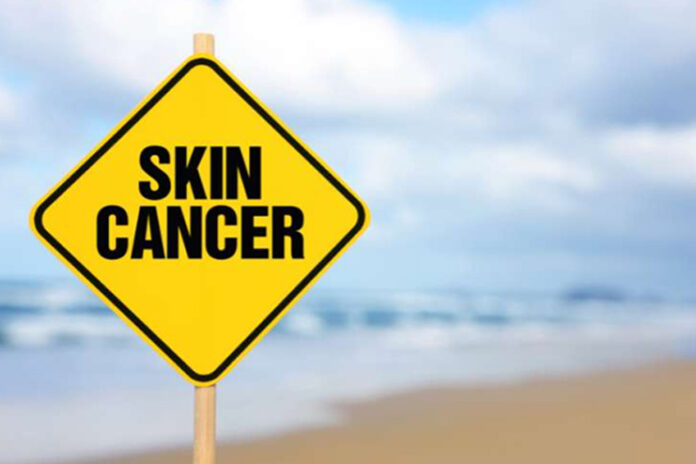Affiliate Disclaimer
Some links in this article are affiliate links. We may earn a small commission if you make a purchase through these links, at no extra cost to you. We only recommend products we find useful to our readersOne of the most prevalent cancers in the world is skin cancer, a silent threat that can appear gradually. However, early detection can make all the difference. Small, seemingly unimportant changes to skin, such as new moles or changes to existing ones, are frequently the first indications of skin cancer. But your body uses these quiet signals to tell you something isn’t quite right.
Millions of people get affected by skin cancer each year, and as a result of changing lifestyles and increased sun exposure, the disease is becoming more common. Awareness—knowing what to look for and identifying the early signs of skin cancer—is the key to improving results.
Types Of Skin Cancer:
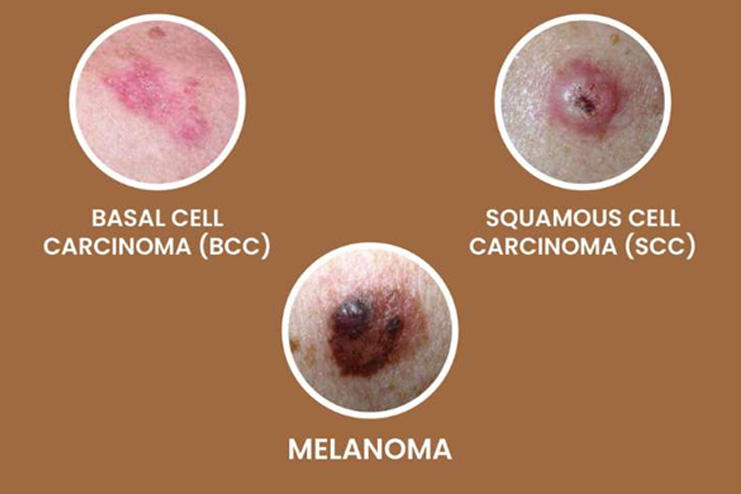
1. Basal cell carcinoma (BCC) :
Basal cell carcinoma (BCC): Basal cell carcinoma (BCC), a type of skin cancer, is more common in people with lighter skin but can also affect those with darker skin tones. BCC frequently resembles a pinkish patch of skin, a pearl-like lump, or a spherical growth the color of flesh. They typically appear after years of indoor tanning or prolonged sun exposure. BCCs are most frequently found on the head, neck, and arms, although they can develop anywhere on the body, including the chest, belly, and legs.
2. Squamous cell carcinoma (SCC) :
The second most prevalent kind of skin cancer is squamous cell carcinoma (SCC). SCC is more common in people with lighter skin, but those with darker skin tones are also susceptible to developing this type of skin cancer. SCC frequently manifests as a scaly patch, red hard bump, or healing sore that reopens. Skin frequently exposed to the sun, such as the back, arms, chest, neck, face, and ear rim, is more likely to develop SCC.
3. Melanoma Skin Cancer:
Melanoma develops in cells known as melanocytes. These cells produce the brown pigment melanin, which gives skin its color and provides protection from the sun’s harmful UV rays. Because melanin can spread to other parts of the body, this is the most dangerous kind of skin cancer.
ABCDE Check for Melanoma Skin Cancer Signs and Symptoms:
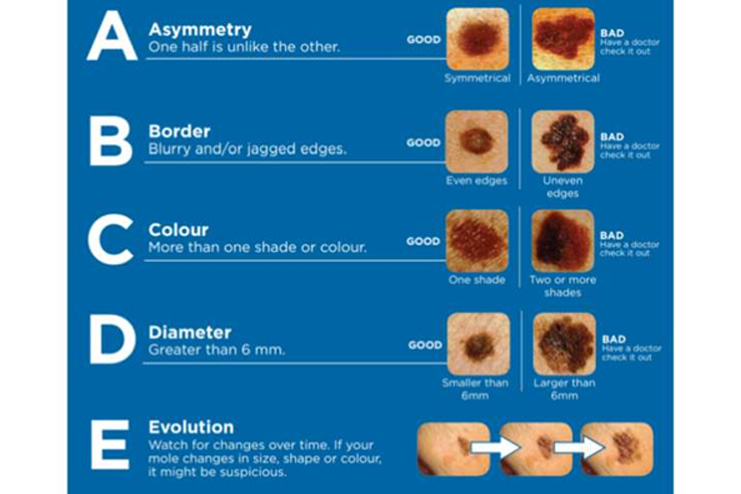
1. A Stands For Asymmetry:
Asymmetry means the mole is not symmetrical, and when cut into half, the two sides do not match each other. Normal moles or benign forms are symmetrical. When checking the recent freckle, imagine a line dividing the mole into two halves, and assuming that, check for symmetry. For asymmetrical moles, see your dermatologist as soon as possible.
2. B Stands For Border:
A nondangerous and normal mole will have specific borders, but a melanoma lesion has blurred and irregular borders. Its edges are rugged and do not show any bordering lines.
3. C Stands For Color:
The color of a normal mole is always specific and stays the same over the years. However, a melanoma skin cancer mole has different colors, from red, purple, brown, and yellow to more shades. They are suspicious and may change color constantly. A dermatologist must soon check such moles with shades of light and dark and various colors.
4. D Stands For Diameter:
A dermatologist must quickly check a mole with a diameter larger than a pencil eraser. Normal moles are small and have a fixed diameter, while melanoma moles have big and spread-out diameters.
5. E Stands For Evolving:
Melanoma skin cancer is evolving; that is, its shape is changing constantly. It may shrink some time, grow more significant other times, change its color, and even be bleeding and itchy. Be sure to consult your dermatologist quickly in case of moles that are elevated and raised from the skin. Melanoma skin cancer moles often grow in size and change their shape rapidly.
Signs and Symptoms of Basal Cell Carcinoma (BCC) Skin Cancer:
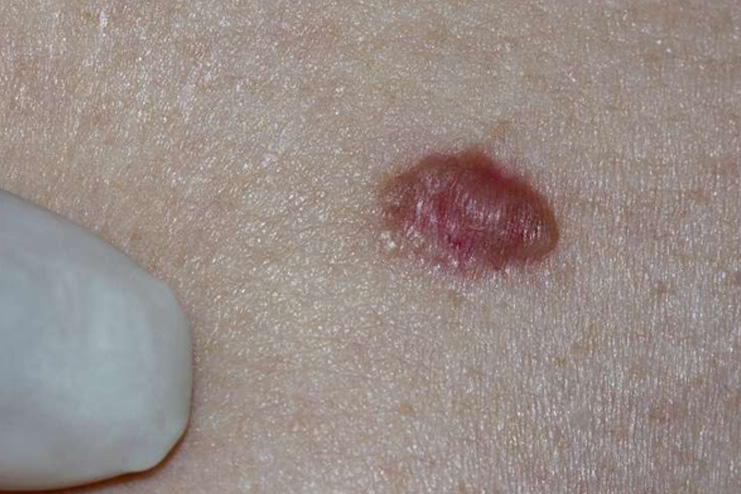
The signs and symptoms of the basal cell carcinoma skin cancer are often confused with typical skin injury. It must be detected early and treated on time; otherwise, it may become dangerous.
- A growth that dips in the middle and is pink or reddish. The cheek’s basal cell carcinoma can be confused with a little cut.
- A skin area on or near the ear that is scaly or expanding.
- Persistent sores or ulcers that bleed, scab, or heal momentarily before reopening may indicate BCC.
- BCCs can occasionally have telangiectasia, or visible blood vessels, surrounding or on the lesion, giving the affected area a “spider-vein” appearance.
- Red or pink growths may have a crusty center and a rolling border. Their edges may eventually become sharper.
Signs and Symptoms of Squamous Cell Carcinoma Skin Cancer:
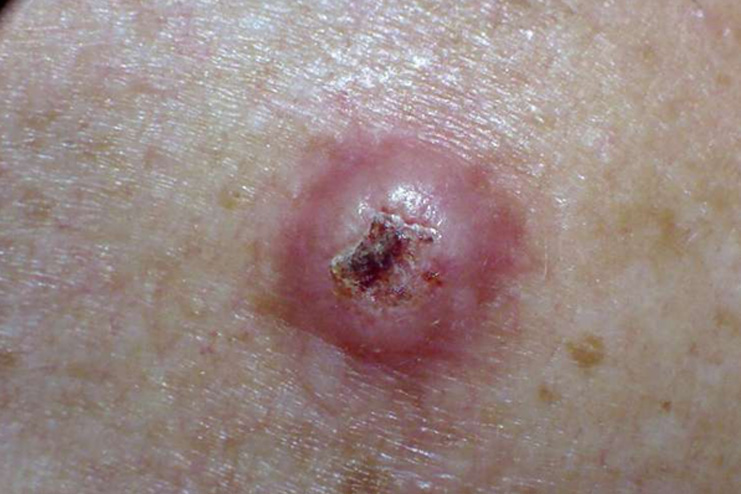
- A nodule is a hard lump on the skin. The nodule may have a different appearance or the same hue as the skin. Depending on the color of the skin, it may appear pink, red, black, or brown.
- A scaly, rough area on the lip that could develop into an open sore.
- Persistent lesions that bleed, crust, or do not fully heal may indicate SCC. They might repeatedly scab over and then reopen.
- An area inside the mouth that is rough or painful.
- Thick, rough patches, particularly in places regularly exposed to the sun, may indicate SCC. These patches could display chronic discomfort or be touch-sensitive.
Signs and Symptoms of Melanoma Skin Cancer:
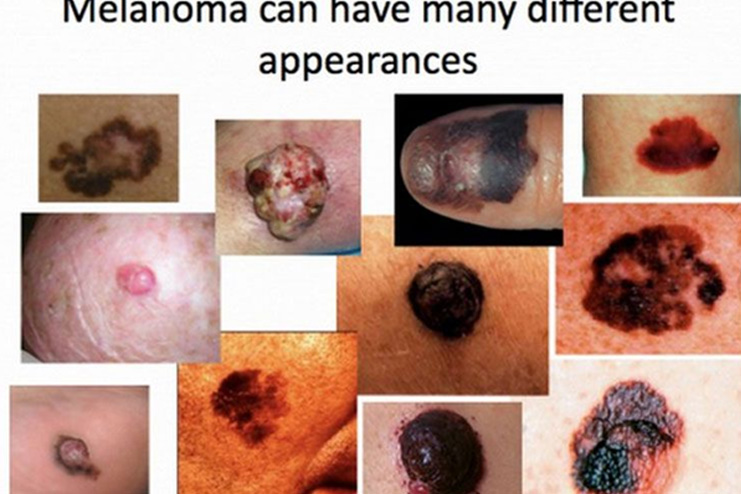
- If a mole has appeared recently and is showing weird signs
- If an existing mole becomes itchy suddenly
- If a mole is significant and does not look symmetric
- If a mole is getting bigger and swelling
- If a mole starts paining and even bleeds
- If a mole develops a crust or becomes elevated
- If a mole is strangely shaped and does not have a firm boundary
- If a mole has many colors and shades
5 Early Signs of Skin Cancer: Spot Them Early:
Early detection of skin cancer symptoms can save lives. Here are five critical signs to look out for:
Moles on Your Skin: While most are harmless, some can be dangerous. A mole may indicate an issue if it changes in size, shape, or color. Learn the ABCDE rule (Asymmetry, Border, Color, Diameter, Evolution) for moles; these rules can aid in the early detection of skin cancer.
Itching, Pain, or Tenderness: Although skin cancer frequently starts quietly, certain places may experience itching, tenderness, or even pain as the disease advances. Since most skin changes don’t cause this irritation, it’s time to take notice if your discomfort persists. You should see a healthcare professional if you have sensitivity or persistent pain as an early warning sign.
Lumps and Bumps: If you see hard pink, red, or purple lumps or bumps on your skin, you may be looking at early indicators of skin cancer. Keep an eye out for any growths beneath the surface of your skin that feel strange, especially if they don’t go away. Early detection of such tumors is essential for the detection of skin cancer.
Bleeding or The Oozing From a Mole or Lesion: Fluid-oozing lesions or bleeding moles are warning signs. Minor cuts and scrapes heal, but a persistently bleeding mole or area is not. Persistent bleeding is a warning sign you should not disregard, as it may point to a significant problem requiring immediate evaluation.
Unusual Color Changes or Irregular Borders: Unexpected hues such as pink, red, white, or blue might appear on skin cancer lesions. Another symptom that could point to melanoma is irregular borders, where the edges seem jagged or uneven. Such mole visual alterations may concern melanoma indicators requiring immediate medical intervention.
Use Body Map To Keep A Schedule Of Moles And Skin Lesions In Your Body:
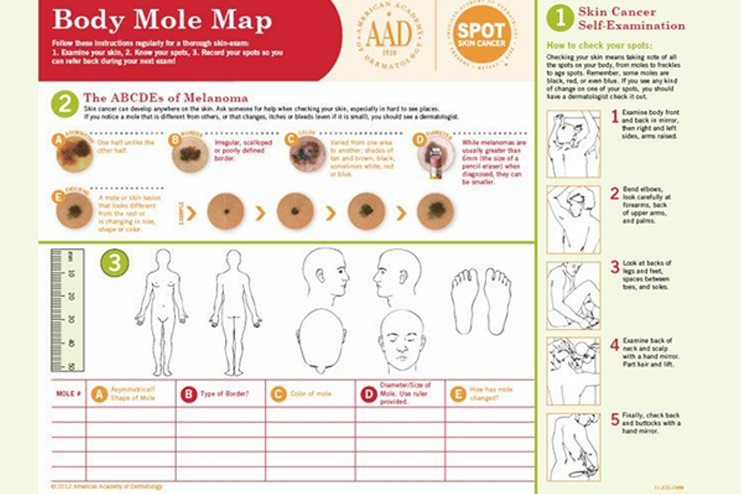
Download printable maps and keep recording and updating. Validate them every month to check for early signs of skin cancer.
Conclusion
One of the most effective ways to spot the early warning of skin cancer and take charge of your health is through early detection. You’re putting your health first and promoting successful skin cancer prevention by continuing to pay attention to any odd changes in your skin. Establish the practice of checking your skin once a month, and be bold and see a doctor if something seems strange. Remember that protecting your skin is very essential for your long-term health, not only the present. Protect your skin, act, and keep yourself informed! Your future self will appreciate it.
-
May 2017Written by Minu Manisha
-
Nov 2024Edited by Ankita
References
- https://www.aad.org/public/diseases/skin-cancer/types/common
- https://my.clevelandclinic.org/health/diseases/15818-skin-cancer
- https://www.brownhealth.org/be-well/skin-cancer-and-5-signs-watch
- https://www.gentlecure.com/what-are-the-beginning-signs-of-skin-cancer
- https://www.cancer.org/cancer/latest-news/how-to-spot-skin-cancer.html
- https://www.beaumont.org/conditions/melanoma/abcde’s-of-melanoma
- https://www.medicalnewstoday.com/articles/abcde-skin-cancer#abcde-rule
- https://www.mayoclinic.org/diseases-conditions/basal-cell-carcinoma/symptoms-causes/syc-20354187
- https://www.aad.org/public/diseases/skin-cancer/types/common/bcc/symptoms
- https://www.skincancer.org/skin-cancer-information/squamous-cell-carcinoma/scc-warning-signs-and-images
- https://www.mayoclinic.org/diseases-conditions/squamous-cell-carcinoma/symptoms-causes/syc-20352480
In this Article

















